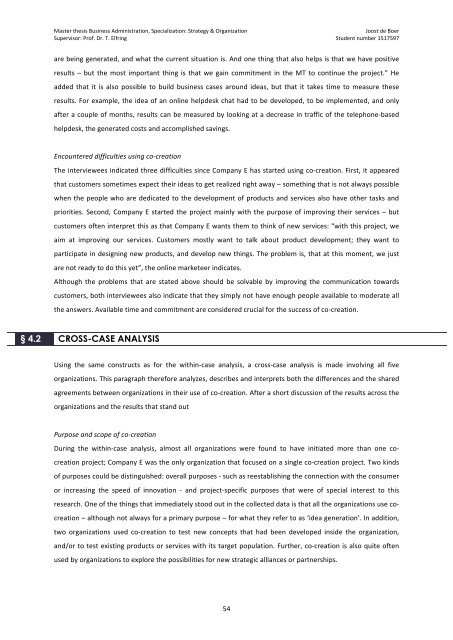Download PDF (English) - Future Ideas
Download PDF (English) - Future Ideas
Download PDF (English) - Future Ideas
You also want an ePaper? Increase the reach of your titles
YUMPU automatically turns print PDFs into web optimized ePapers that Google loves.
Master thesis Business Administration, Specialization: Strategy & Organization <br />
Supervisor: Prof. Dr. T. Elfring <br />
Joost de Boer <br />
Student number 1517597 <br />
are being generated, and what the current situation is. And one thing that also helps is that we have positive <br />
results – but the most important thing is that we gain commitment in the MT to continue the project.” He <br />
added that it is also possible to build business cases around ideas, but that it takes time to measure these <br />
results. For example, the idea of an online helpdesk chat had to be developed, to be implemented, and only <br />
after a couple of months, results can be measured by looking at a decrease in traffic of the telephone-‐based <br />
helpdesk, the generated costs and accomplished savings. <br />
Encountered difficulties using co-‐creation <br />
The interviewees indicated three difficulties since Company E has started using co-‐creation. First, it appeared <br />
that customers sometimes expect their ideas to get realized right away – something that is not always possible <br />
when the people who are dedicated to the development of products and services also have other tasks and <br />
priorities. Second, Company E started the project mainly with the purpose of improving their services – but <br />
customers often interpret this as that Company E wants them to think of new services: “with this project, we <br />
aim at improving our services. Customers mostly want to talk about product development; they want to <br />
participate in designing new products, and develop new things. The problem is, that at this moment, we just <br />
are not ready to do this yet”, the online marketeer indicates. <br />
Although the problems that are stated above should be solvable by improving the communication towards <br />
customers, both interviewees also indicate that they simply not have enough people available to moderate all <br />
the answers. Available time and commitment are considered crucial for the success of co-‐creation. <br />
§ 4.2 CROSS-CASE ANALYSIS<br />
Using the same constructs as for the within-‐case analysis, a cross-‐case analysis is made involving all five <br />
organizations. This paragraph therefore analyzes, describes and interprets both the differences and the shared <br />
agreements between organizations in their use of co-‐creation. After a short discussion of the results across the <br />
organizations and the results that stand out <br />
Purpose and scope of co-‐creation <br />
During the within-‐case analysis, almost all organizations were found to have initiated more than one co-creation<br />
project; Company E was the only organization that focused on a single co-‐creation project. Two kinds <br />
of purposes could be distinguished: overall purposes -‐ such as reestablishing the connection with the consumer <br />
or increasing the speed of innovation -‐ and project-‐specific purposes that were of special interest to this <br />
research. One of the things that immediately stood out in the collected data is that all the organizations use co-creation<br />
– although not always for a primary purpose – for what they refer to as ‘idea generation’. In addition, <br />
two organizations used co-‐creation to test new concepts that had been developed inside the organization, <br />
and/or to test existing products or services with its target population. Further, co-‐creation is also quite often <br />
used by organizations to explore the possibilities for new strategic alliances or partnerships. <br />
54





